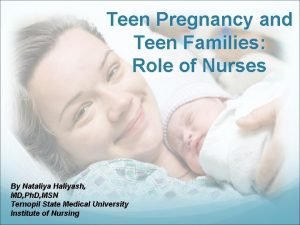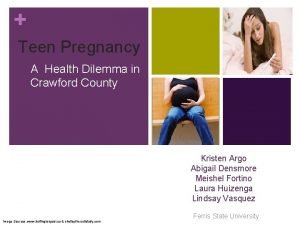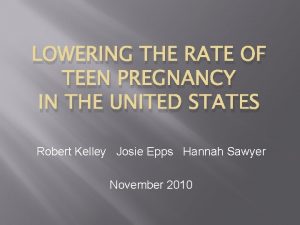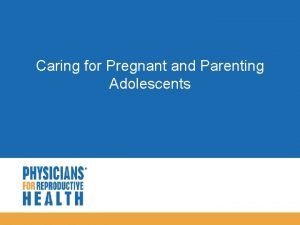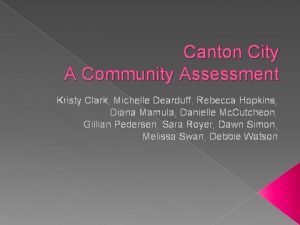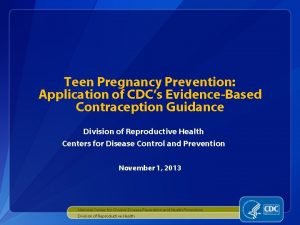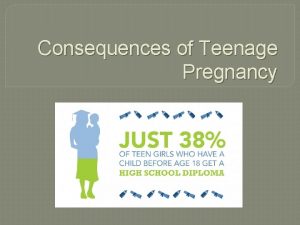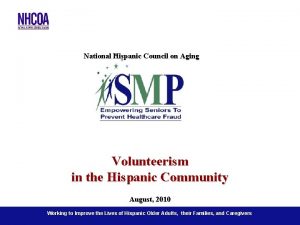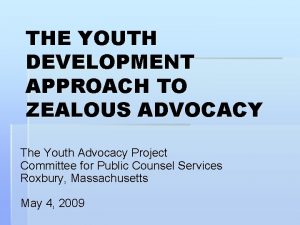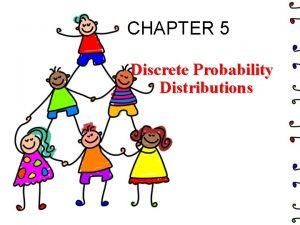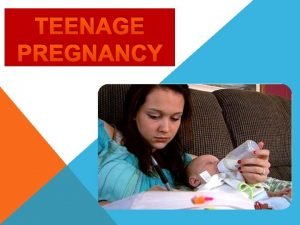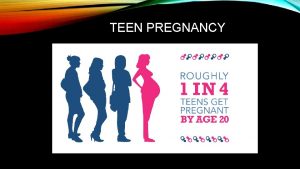Aggregate At Risk Hispanic Teenagers and Teenage Pregnancy



































- Slides: 35

Aggregate At Risk Hispanic Teenagers and Teenage Pregnancy By Eve Wittlin-Young , RN

Demographics, Epidemiological and Statistical Data �The United States holds the highest rates of teen pregnancy in the western industrialized world, with Florida rated as the sixth highest in the nation (Family first aid, 2004). � After a consistent and steady decline since the early 1990 s, teen pregnancies and birth rates are on the rise with teen pregnancy up 3% and birth rates showing a 5% increase (The National Campaign, 2010).

Demographics, Epidemiological and Statistical Data continued • It is estimated that 750, 000 American teenagers become pregnant every year (Maurer & Smith, 2009). • The National Campaign to prevent teen and unplanned pregnancy (2010), states that eight in ten of these pregnancies are unintended and 81 percent are to unmarried teens.

Demographics, Epidemiological and Statistical Data continued This is a Statespecific teenage birth rates map that presents the data for 15 -19 year olds birth rates by state. This presents the fact that the rates are highest across the Southern United States (NCHS, 2010).

Demographics, Epidemiological and Statistical Data continued �Minority teens are most vulnerable to first coitus at early age with subsequent childbearing. �In 2003, Hispanic and African American teens had birth rates more than double that for Caucasian teens. Talashek, Alba, & Patel, 2006

Demographics, Epidemiological and Statistical Data continued This chart presents the data that Hispanics have consistently had the highest births rates among racial groups in the U. S. The National Campaign, 2008

Demographics, Epidemiological and Statistical Data continued �Teenage birth rates have historically been higher for Hispanic teenagers than for non-Hispanic white teenagers (NCHS, 2010) �A study by the National Center for Health Statistics showed that, in the United States, Hispanic teenagers (age 15 -19) have the highest pregnancy rates at 81. 8, while White non-Hispanic teenage girls have the least at 27. 2, and with African American non-Hispanic girls in the middle at 64. 2 per 1, 000 women in 2007 (NCHS, 2010).

Demographics, Epidemiological and Statistical Data continued �Interestingly, rates for non-Hispanic white and Hispanic teenagers were uniformly higher in the Southeast and lower in the Northeast and California (NCHS, 2010). �In 2007, the birth rate for Hispanic teenagers, 81. 8 per 1, 000 aged 15– 19 years, which was nearly three times the rate for non-Hispanic white teenagers, 27. 2 (NCHS, 2010)

Demographics, Epidemiological and Statistical Data �Compared with the national birth rate for Hispanic teenagers, birth rates were significantly lower for Hispanic teenagers in California, New York, New Jersey, and Florida, which together accounted for 38% of Hispanic teenage births in 2007 (NCHS, 2010). �However, state-specific birth rates for Hispanic teenagers exceeded the national Hispanic teenage birth rate in 35 states and the District of Columbia (NCHS, 2010).

Demographics, Epidemiological and Statistical Data continued This graph visually depicts the birth rates for unmarried woman by race comparing the years of 1995, 2002 and 2006. CDC, 2009

Social, Political, Economic and Cultural factors and their impact �With teen pregnancy and birth come many social, political and economic consequences: �Statistics show that only about one third of pregnant teenagers go on to receive their diploma (Swierzewski, 2007). � More than 50% of all teen mothers receive welfare assistance after the birth of their child (Maurer & Smith, 2009) �An estimated $23. 6 billion in services was provided in 2004 to families headed by females who were teens when they had their first child (Maurer & Smith, 2009)

Social, Political, Economic and Cultural factors and their impact �Seventy percent of women receiving Temporary Assistance for Needy Families, TANF, say their trusted source of information on preventing pregnancy is a healthcare professional, however, only forty percent say they have actually received information about preventing pregnancy from their provider. Brown, S. , 2010

Social, Political, Economic and Cultural factors and their impact continued �Other consequences of teen pregnancy that studies conclude include children of teen mothers have: 1. Lower birth weights 2. Are more likely to perform poorly in school 3. Are at a greater risk for abuse and neglect (Maurer & Smith, 2009). �Interestingly statistics also show that the sons of teen mothers are thirteen percent more likely to end up in prison and teen daughters are twenty two percent more likely to become teen moms themselves (Family First Aid, 2004).

Social, Political, Economic and Cultural factors and their impact continued � Teen pregnancies cost the United States at least seven billion dollars annually from lost tax revenues, public assistance, child health care, foster care and involvement in the criminal justice system (Swierzewski, 2007). � Clearly, teen pregnancy not only effects the teens and their families but it affects the health and well being of the entire Nation, as well as our communities.

Social, Political, Economic and Cultural factors and their impact continued Cultural Factors: � Hispanic teenagers who become pregnant are less likely to have an abortion, experts believe the lower abortion rates is related to the large number of Roman Catholics among the nation’s Hispanics (Melby, T. , 2006). � Teen pregnancy is not necessarily forbidden in the Hispanic community, many times the Hispanic girl will receive great support from family and friends (Melby, T. , 2006). � African Americans chose abortion at twice the rate of Hispanic teens, 49. 4 per 1000 versus 28. 5 per 1000 (Maurer & Smith, 2009).

Social, Political, Economic and Cultural factors and their impact continued Sociocultural Factors �Hispanic adolescents with higher acculturation levels are more likely to be sexually active than adolescents with lower acculturaton (Talashek, Alba, & Patel, 2006). �Many girls report that in their social circles early childbearing was common, almost 70% identified an adolescent friend or sibling who was either pregnant or had a child (Maurer & Smith, 2009).

Prevalent Health Problems �Teen mothers and their infants are at greater risk for serious medical complications, infant low birth weight, and poorer outcomes than older women and their infants (Maurer & Smith, 2009).

Prevalent Health Problems continued � A third of pregnant teens receive inadequate prenatal care � Many delay seeking prenatal care or do not receive regular care � Pregnant adolescents are more likely to smoke and about 50% of all pregnant teens drink during their pregnancy Maurer & Smith, 2009 • Hispanic teens may not have access to health care services • Language skills, poverty and immigration status are barriers preventing many Hispanics from finding the adequate healthcare needed Melby, T. , 2006

Prevalent Health Problems continued �Teenagers are at a greater risk for developing pregnancy induced hypertension and toxemia �Teenagers are also at an increased risk for anemia, nutritional deficiencies, poor weight gain and urinary tract infections Maurer & Smith, 2009

Prevalent Health Problems continued � 20% of teens do not use protection during intercourse �Each year, about 9 million adolescents contract an STD �In 2008, a Centers for Disease Control and Prevention study reported that 26% of girls between the ages of 14 and 19 (3. 2 million girls) were infected with at least one common type of STD Maurer & Smith, 2009

Prevalent Health Problems continued Healthy People 2020 National Objectives Related to Teen Pregnancy �FP HP 2020– 8 Reduce the pregnancy rate of adolescent females �FP HP 2020– 9: Increase the proportion of adolescents aged 17 years and under who have never had sexual intercourse. (USDHHS, 2009)

Prevalent Health Problems continued � FP HP 2020– 10: Increase the proportion of sexually active adolescents aged 15 to 19 years who use contraception that both effectively prevents pregnancy and provides barrier protection against disease. � FP HP 2020– 11: Increase the proportion of adolescents who received formal instruction on reproductive health topics before they were 18 years old. � FP HP 2020– 15: Increase the percentage of women in need of publicly supported contraceptive services and supplies who receive those services and supplies. � AH HP 2020– 3: Increase the percentage of adolescents who have been tested for HIV. USDHHS, 2009)

Prevalent Health Problems continued � MICH HP 2020– 7: Reduce low birth weight (LBW) and very low birth weight (VLBW). �MICH HP 2020– 10: Increase abstinence from alcohol, cigarettes, and illicit drugs among pregnant women. �MICH HP 2020– 17: (Developmental) Increase the proportion of mothers who achieve a recommended weight gain during their pregnancies. �MICH HP 2020– 5: Increase the proportion of pregnant women who receive early and adequate prenatal care. USDHHS, 2009)

Health Beliefs and Practices �During early adolescence feelings of affiliation and abandonment are prevalent; girls tend to know themselves through relationships with others (Talashek, Alba, & Patel, 2006). �Many teenage girls say that they have little knowledge of even common contraceptive methods such as condoms and the pill, and most have not even heard of the less common methods such as the implant (Brown, S. , 2010). �Many teenage girls claim that it doesn’t matter whether birth control is used and state “when it is your time to get pregnant it will happen” (Brown, S. , 2010).

Health Belief and Practices continued �With the increase in sexual activity among teenagers, there is not necessarily an increased knowledge about sexual function or birth control. �Teenagers lack accurate knowledge about birth control methods and the correct use of contraceptives �Cost is an issue for most teenagers to practice effective birth control methods Maurer & Smith, 2009

Health Beliefs and Practices continued �Fewer than one half (46 %) of all unmarried Hispanic teens said they would be “very upset” if they became pregnant � Some Hispanic women are not viewed as women until they become mothers. Also, the yearning to have children in response to gender roles and responsibilities are a few of the cultural beliefs. Melby, T. , 2006

Prioritized Problems, Needs and Risks for Hispanic Teenagers and Pregnancy In order to effectively address teen pregnancy among our Hispanic population we must first establish and prioritize the problems, needs and risks for this aggregate.

Prioritized Problems, Needs and Risks for Hispanic Teenagers and Pregnancy continued �Prioritized Problem 1: Deficient Knowledge of Sexual Education �Deficient Knowledge of sexual education among Hispanic teenage girls related to lack of exposure, misbeliefs, and unfamiliarity with information resources as evidenced by the high rates of STDs among teenagers and the high birth rates of Hispanic teenagers. �Address the deficient knowledge of sexual education in order to promote a delay in sexual activity and or increase the use of contraceptives in hopes to decrease risky behaviors that may lead to teen pregnancy and STDs. Address the misbeliefs of the Hispanic teenagers and encourage academic goals and life purpose.

Prioritized Problems, Needs and Risks for Hispanic Teenagers and Pregnancy continued � Prioritized Problem 2: Risk for Impaired Health Maintenance � Risk for Impaired Health Maintenance among Hispanic teenage girls related to altered communication skills, lack of resources, insufficient planning, insufficient finances, and lack of knowledge as evidence by Hispanic teenagers receiving inadequate prenatal care, not having the access to health care services for prenatal care, possible language barriers, poverty and the fact that they are more likely to smoke and about 50% of all pregnant teens drink during their pregnancy. � Outcome: Increase the access of services in order for this aggregate at risk to obtain early prenatal, encourage consistent prenatal care through ease of services and education, offer more bilingual assistance to encourage proper health maintenance. Assess, teach and monitor the teen mom in order to maintain nutritional status and prevent medical complications to ultimately produce a healthy birth and delivery for mom and infant.

Prioritized Problems, Needs and Risks for Hispanic Teenagers and Pregnancy continued � Prioritized Problem 3: Risk for Altered Parenting � Risk for Altered Parenting related to lack of experience, lack of knowledge, and ineffective role model as evidence by the conclusion of studies that suggest the children of teen mothers are at a greater risk for abuse and neglect, as well as the statistics that show the sons of teen mothers are thirteen percent more likely to end up in prison and teen daughters are twenty two percent more likely to become teen moms themselves. � Outcomes: Prevent neglect and abuse among the children of teenage mothers. Hispanic teen mothers will attend parenting classes and utilize other community resources as needed in order to increase knowledge on parenting skills, learn expected growth and development of their child and increase their support system.

Plan of Care: Primary, Secondary and Tertiary Strategies Primary Prevention Primary prevention has three focuses: 1. Delay or stop participation in sexual activity 2. To provide access to contraceptives 3. To strengthen future goals Intervention Strategies � Strengthen the education of Hispanic teenagers through comprehensive sex education that provides accurate information about the risks and consequences of teen sexual activity such as the risk of contracting STDs, pregnancy, possibility of not obtaining their high school diploma, risks of medical complications and living in poverty. � Teach the effectiveness and correct use of contraceptives. � Discuss family planning that addresses the stress and consequences of becoming a teen parent and encourage academic and future goals. Maurer & Smith, 2009

Plan of Care: Primary, Secondary and Tertiary Strategies Secondary Prevention Secondary prevention should focus on reducing the health risks for both the pregnant teenager and her infant. Intervention Strategies �Promote early detection with the use of free pregnancy screenings, as well as providing education to teenagers of the early signs of pregnancy such as fatigue, nausea, vomiting, and missed menstrual periods �Offer education on pregnancy resolution services such as abortion and adoption. �Investigate all of the financial options and prenatal programs for the pregnant teen in order to obtain early and regular prenatal care. Maurer & Smith, 2009

Plan of Care: Primary, Secondary and Tertiary Strategies Tertiary Prevention Tertiary prevention should focus on how to improve the chances of self- sufficiency while ensuring a healthy and supportive environment to the child. Intervention Strategies �Discuss and investigate contraceptive methods to prevent future unintended pregnancies from occurring �Assess parenting skills and offer parenting classes, individual counseling, and peer support groups. Maurer & Smith, 2009

References: � Brown, S. (2010). Preventing Teen Unplanned & Pregnancy. Policy & Practice (19426828), 68(2), 11 -14. Retrieved from EBSCOhost January 20, 2011. � Centers for Disease Control and Prevention. (2009) Changing Patterns of Nonmarital Childbearing in the United States. Retrieved January 16, 2011, from http: //www. cdc. gov/nchs/databriefs/db 18. htm � Family First Aid. (2004). Teen Pregnancy Statistics, Facts and Prevention. Retrieved January 19, 2011, from http: //www. familyfirstaid. org/teenpregnancy. html � Maurer, F. , & Smith, C. (2009). Community/ Public Health Nursing Practice: Health For Families and Populations (4 th ed. ). St Louis, MO: Elsevier Saunders. � Melby, T. (2006). Hispanics become focus of teen pregnancy prevention efforts. Contemporary Sexuality, 40(4), 1 -6. Retrieved from EBSCOhost � National Center for Health Statistics. (2010) State Disparities in Teenage Birth Rates in the United States. Retrieved January 16, 2011, from http: //www. cdc. gov/nchs/databriefs/db 46. pdf

References: � Swierzewski, S. (2007). Teen Pregnancy. Retrieved January 22, 2011, from http: //www. womenshealthchannel. com/teenpregnancy/index. shtml � Talashek, M. L. , Alba, M. L. , & Patel, A. (2006). Untangling the Health Disparities of Teen Pregnancy. Journal for Specialists in Pediatric Nursing, 11(1), 14 -27. Retrieved January 20, 2011, from Academic Search Premier. � The National Campaign. (2008). A Look at Latinos: An Overview of Latina Teen Pregnancy and Birth Rate. Retrieved January 20, 2011, from http: //www. thenationalcampaign. org/espanol/PDF/latino_overview. pdf � The National Campaign. (2010). The National Campaign to Prevent Teen and Unplanned Pregnancy. Retrieved January 19, 2011, from http: //www. thenationalcampaign. org/national/ � United States Department of Health and Human Services. (2009). Proposed Healthy People 2020 Objectives. Retrieved January 22, 2011, from http: //www. healthypeople. gov/hp 2020/Objectives/Topic. Areas. aspx
 Hispanic cultural views on teenage pregnancy
Hispanic cultural views on teenage pregnancy Nursing theories related to teenage pregnancy
Nursing theories related to teenage pregnancy Way to prevent teenage pregnancy
Way to prevent teenage pregnancy Causes of teenage pregnancy
Causes of teenage pregnancy Lack of knowledge in teenage pregnancy
Lack of knowledge in teenage pregnancy Teenage pregnancy seminar objectives
Teenage pregnancy seminar objectives Lack of knowledge in teenage pregnancy
Lack of knowledge in teenage pregnancy Nulliparous
Nulliparous For teenage pregnancy
For teenage pregnancy For teenage pregnancy
For teenage pregnancy Implantation spotting
Implantation spotting Shift in sras curve
Shift in sras curve How to calculate aggregate demand
How to calculate aggregate demand How to mix aggregate and non aggregate tableau
How to mix aggregate and non aggregate tableau Aggregate supply shifters
Aggregate supply shifters Unit 3 aggregate demand aggregate supply and fiscal policy
Unit 3 aggregate demand aggregate supply and fiscal policy Unit 3 aggregate demand aggregate supply and fiscal policy
Unit 3 aggregate demand aggregate supply and fiscal policy Liquidity measures
Liquidity measures Famous latino singer
Famous latino singer National hispanic council on aging
National hispanic council on aging Hispanic american scientists
Hispanic american scientists Is hispanic an ethnicity
Is hispanic an ethnicity Is hispanic an ethnicity
Is hispanic an ethnicity Domestic violence in the hispanic community
Domestic violence in the hispanic community Most famous hispanic artists
Most famous hispanic artists Hispanic dude
Hispanic dude Communication between parents and teenagers
Communication between parents and teenagers Nuclear dyad family
Nuclear dyad family Zealous
Zealous Michigan state police teenage defensive driving
Michigan state police teenage defensive driving Short term teenage goals
Short term teenage goals Big data is like teenage
Big data is like teenage Chicken soup for the teenage soul poems
Chicken soup for the teenage soul poems Chapter 5 discrete probability distributions
Chapter 5 discrete probability distributions Big data is like teenage
Big data is like teenage Pbs frontline inside the teenage brain
Pbs frontline inside the teenage brain

